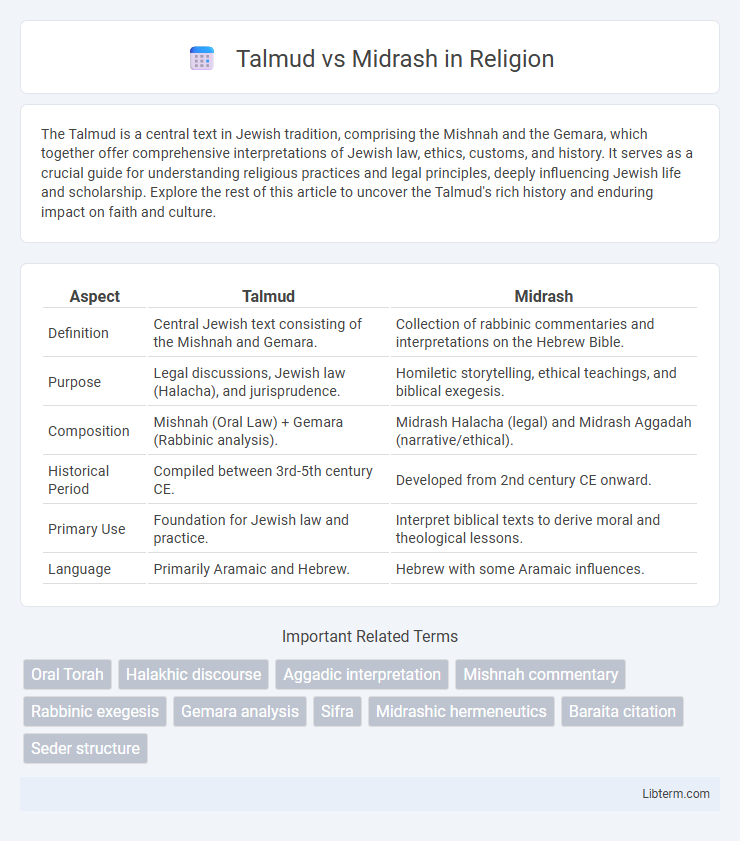The Talmud is a central text in Jewish tradition, comprising the Mishnah and the Gemara, which together offer comprehensive interpretations of Jewish law, ethics, customs, and history. It serves as a crucial guide for understanding religious practices and legal principles, deeply influencing Jewish life and scholarship. Explore the rest of this article to uncover the Talmud's rich history and enduring impact on faith and culture.
Table of Comparison
| Aspect | Talmud | Midrash |
|---|---|---|
| Definition | Central Jewish text consisting of the Mishnah and Gemara. | Collection of rabbinic commentaries and interpretations on the Hebrew Bible. |
| Purpose | Legal discussions, Jewish law (Halacha), and jurisprudence. | Homiletic storytelling, ethical teachings, and biblical exegesis. |
| Composition | Mishnah (Oral Law) + Gemara (Rabbinic analysis). | Midrash Halacha (legal) and Midrash Aggadah (narrative/ethical). |
| Historical Period | Compiled between 3rd-5th century CE. | Developed from 2nd century CE onward. |
| Primary Use | Foundation for Jewish law and practice. | Interpret biblical texts to derive moral and theological lessons. |
| Language | Primarily Aramaic and Hebrew. | Hebrew with some Aramaic influences. |
Introduction to Talmud and Midrash
The Talmud, a central text of Rabbinic Judaism, comprises the Mishnah and the Gemara, offering comprehensive legal discussions and interpretations of the Torah. Midrash, in contrast, consists of rabbinic commentaries and stories that explore biblical narratives, emphasizing moral and theological lessons. Both texts serve as foundational sources for Jewish law and ethics, with the Talmud providing detailed legal analysis and Midrash delivering homiletic insights.
Historical Origins of Talmud and Midrash
The Talmud, originating around the 3rd to 5th centuries CE, is a central text in Rabbinic Judaism consisting of the Mishnah and Gemara, reflecting centuries of legal discussions and interpretations. Midrash, developed earlier from the 2nd century CE onward, comprises a collection of exegetical commentaries on the Hebrew Scriptures aimed at elucidating biblical narratives and laws. Both texts emerged during the formative period of Rabbinic Judaism, serving distinct yet complementary roles in Jewish law and theology.
Core Definitions: What is the Talmud?
The Talmud is a central Jewish text composed of the Mishnah and the Gemara, serving as a comprehensive legal and ethical commentary on the Torah. It systematically analyzes laws, traditions, and biblical narratives, forming the foundation of Rabbinic Judaism. Distinct from the Midrash, the Talmud emphasizes legal discourse and dialectical reasoning alongside narrative interpretation.
Core Definitions: What is the Midrash?
The Midrash is a collection of ancient Jewish biblical interpretations and commentaries that explore the deeper meanings of the Hebrew Scriptures through storytelling, parables, and legal exegesis. It serves as a foundational text for understanding Jewish law, ethics, and theology by expanding on the narratives and laws found in the Torah. Unlike the Talmud, which combines Mishnah and Gemara focusing largely on legal debates, Midrash emphasizes moral lessons and spiritual insights from scripture.
Structural Differences Between Talmud and Midrash
The Talmud consists of the Mishnah and Gemara, forming a comprehensive legal and ethical discourse rooted in rabbinic analysis and debate, whereas the Midrash primarily offers interpretative and homiletical expansions on biblical texts. Structurally, the Talmud follows a systematic, dialectical format with defined sugiyot (topics) and rigorous commentary, while the Midrash employs a more narrative and thematic approach, often grouping stories and explanations according to biblical verses. The Talmud's focus is on law (Halacha) through detailed argumentation, contrasting with the Midrash's emphasis on theological, moral, and imaginative exploration of scripture.
Purposes and Uses in Jewish Tradition
The Talmud serves as the central text for Jewish law and ethics, providing detailed legal analysis and practical guidance for religious observance. Midrash complements the Talmud by offering interpretive stories, ethical teachings, and theological insights that deepen understanding of the Hebrew Bible. Together, the Talmud and Midrash shape Jewish religious practice and education by blending legal rigor with narrative interpretation.
Interpretative Methods in Talmud and Midrash
The Talmud employs a dialectical interpretative method characterized by rigorous debate, logical analysis, and resolution of conflicting opinions to derive legal rulings, emphasizing halachic precision. In contrast, Midrash utilizes a homiletic and narrative approach, interpreting biblical texts through allegory, parables, and creative expansions to explore ethical and theological themes. Both methods reflect distinctive techniques: Talmudic discourse centers on legal exegesis and casuistic reasoning, whereas Midrashic literature prioritizes moral lessons and scriptural elucidation beyond literal meanings.
Key Texts and Examples
The Talmud, consisting of the Mishnah and Gemara, serves as a comprehensive legal and ethical commentary on the Torah, exemplified by tractates such as Berakhot and Sanhedrin, which analyze Jewish law and practice in depth. The Midrash, comprising collections like Midrash Rabbah and Midrash Tanchuma, provides narrative expansions, theological insights, and moral lessons through exegetical stories that illuminate biblical texts, such as the creation story in Genesis or Moses' leadership in Exodus. While the Talmud emphasizes legal reasoning and dialectical debate, the Midrash focuses on allegorical and homiletical interpretations to enrich understanding of scripture.
Influence on Jewish Law and Ethics
The Talmud serves as the central source of Jewish law (Halacha), systematically interpreting the Torah and providing detailed legal rulings that govern daily life and religious practices. Midrash, while primarily focused on biblical interpretation and storytelling, contributes ethical insights and moral lessons that complement legal frameworks but do not function as binding law. Together, the Talmud's legal authority and the Midrash's ethical teachings shape the comprehensive development of Jewish law and moral philosophy.
Conclusion: Talmud and Midrash in Modern Judaism
Talmud and Midrash both serve as foundational texts in modern Judaism, with the Talmud providing detailed legal discussions and practical guidance, while Midrash offers interpretative insights and narrative expansions of the Hebrew Bible. Contemporary Jewish study emphasizes the Talmud's role in shaping Halacha (Jewish law) and ethical decision-making, whereas Midrash enriches theological understanding and cultural identity. Together, these texts continue to influence religious practice, education, and communal values within diverse Jewish communities worldwide.
Talmud Infographic

 libterm.com
libterm.com